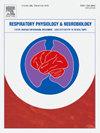慢性阻塞性肺疾病患者运动后的呼吸模式和通气反应。
IF 1.6
4区 医学
Q3 PHYSIOLOGY
引用次数: 0
摘要
背景:慢性阻塞性肺疾病(COPD)患者表现为动态恶性通货膨胀(DH)导致的通气限制。呼吸模式可以用TI/TTOT(吸气时间/总时间)和VT/TI(潮气量/吸气时间)来表示。在健康受试者中,这两个参数在运动性呼吸急促期间显著增加,但从未在COPD中进行过研究。在大型COPD患者队列中,我们分析了休息和最大运动时的TI/TTOT和VT/TI。方法:我们招募了临床稳定且气流阻塞程度较大的COPD患者。所有的参与者都进行了肺活量测定和心肺运动测试(CPET)。结果:234例COPD患者(女性75例;年龄范围41 ~ 89岁),运动时TI/ ttt和VT/TI值分别从0.259±0.040增加到0.304±0.038,从854.1±229,6ml/s增加到2100±622.5ml/s (pI/ ttt峰值与VT/TI峰值呈正相关(p2peak (ml/min/kg),最大负荷(Watt))。TI/ ttt峰值与VT/TI峰值呈正相关(DH患者(ΔIC≥150ml)的pI/ ttt和VT/TI静息值与无DH患者相比,两组间无差异,但无DH患者运动时TI/ ttt显著升高,而VT/TI值无显著升高。结论:COPD患者最大运动时TI/ ttt和VT/TI值显著升高。TI/TTOT值与动态恶性通货膨胀显著相关。我们的研究结果表明,TI/TTOT和VT/TI评估可能为COPD的运动通气限制提供进一步的信息。本文章由计算机程序翻译,如有差异,请以英文原文为准。
Breathing pattern and ventilatory response to exercise in patients with Chronic Obstructive Pulmonary Disease
Background
Patients with Chronic Obstructive Pulmonary Disease (COPD) show ventilatory limitation to exercise due to dynamic hyperinflation (DH). Breathing pattern can be expressed by TI/TTOT (inspiratory time/total time) and VT/TI (tidal volume/inspiratory time). Both parameters significantly increase during exertional hyperpnea in healthy subjects, but they have never been studied in COPD. In a large cohort of COPD patients, we analysed TI/TTOT and VT/TI at rest and during maximal exercise.
Methods
We enrolled clinically stable COPD patients with wide degree of airflow obstruction. All participants underwent spirometry and cardiopulmonary exercise testing (CPET) on a cycle ergometer.
Results
In 234 COPD patients (75 females; age range 41–89 years), TI/TTOT and VT/TI values significantly increased during exercise, from 0.259 ± 0.040–0.304 ± 0.038 and from 854.1 ± 229,6 ml/s to 2100 ± 622.5 ml/s respectively (p < 0.05). TI/TTOT peak and VT/TI peak were positively related (p < 0.05) with VO2peak (ml/min/kg), maximal workload (Watt). TI/TTOT peak, but not VT/TI peak values showed a positive correlation (p < 0.05) with the peak-rest difference of inspiratory capacity (ΔIC, in ml). When related to minute ventilation TI/TTOT and VT/TI rest values in patients with DH (ΔIC ≥150 ml), compared with those without DH, did not differ between the two groups, though TI/TTOT, but not VT/TI values, significantly increased during exercise in patients without DH
Conclusions
TI/TTOT and VT/TI values significantly increase during maximal exercise in COPD. TI/TTOT values were significantly correlated with dynamic hyperinflation. Our results suggest that TI/TTOT and VT/TI assessment may provide further information on exercise ventilatory limitation in COPD.
求助全文
通过发布文献求助,成功后即可免费获取论文全文。
去求助
来源期刊
CiteScore
4.80
自引率
8.70%
发文量
104
审稿时长
54 days
期刊介绍:
Respiratory Physiology & Neurobiology (RESPNB) publishes original articles and invited reviews concerning physiology and pathophysiology of respiration in its broadest sense.
Although a special focus is on topics in neurobiology, high quality papers in respiratory molecular and cellular biology are also welcome, as are high-quality papers in traditional areas, such as:
-Mechanics of breathing-
Gas exchange and acid-base balance-
Respiration at rest and exercise-
Respiration in unusual conditions, like high or low pressure or changes of temperature, low ambient oxygen-
Embryonic and adult respiration-
Comparative respiratory physiology.
Papers on clinical aspects, original methods, as well as theoretical papers are also considered as long as they foster the understanding of respiratory physiology and pathophysiology.

 求助内容:
求助内容: 应助结果提醒方式:
应助结果提醒方式:


